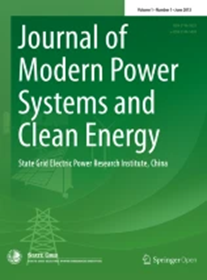Stability and Dynamic Analysis of PMSG-Based Wind Generation System Considering Torsional Oscillation and Virtual Inertia Control
IF 6.1
1区 工程技术
Q1 ENGINEERING, ELECTRICAL & ELECTRONIC
Journal of Modern Power Systems and Clean Energy
Pub Date : 2024-10-15
DOI:10.35833/MPCE.2024.000573
引用次数: 0
Abstract
Most permanent magnet synchronous generator (PMSG) based wind generation systems currently employ grid-following control, relying on a phase-locked loop (PLL) for grid connection. However, it leads to a lack of inertia support in the system. To address this, the virtual inertia control (VIC) is crucial for improvement, yet it introduces potential instability due to torsional oscillation interaction with PLL and low-frequency oscillations, which is an underexplored area. This paper presents a comprehensive analysis of the grid-connected PMSG-based wind generation system. It confirms the necessity of employing a full-order model for studying stability on the quasi-electromechanical timescale (QET) by a comparison with the reduced-order model. Then, a comprehensive modal analysis is conducted to analyze the effect of VIC parameters, shaft inertia time constant, PLL parameters, and torsional oscillation damping (TOD) controller gain on the interaction of QET oscillations under two typical control strategies. The occurrence of interaction and mode conversion is observed when the oscillation frequency and root loci of the torsional, PLL, and low-frequency oscillations are close. Finally, a theoretical analysis is validated via simulation verification in Simulink. These findings offer a valuable guidance for industrial PMSG applications considering VIC.考虑扭振和虚拟惯性控制的pmsg风力发电系统稳定性与动态分析
目前大多数基于永磁同步发电机(PMSG)的风力发电系统采用电网跟随控制,依靠锁相环(PLL)进行电网连接。然而,它会导致系统缺乏惯性支撑。为了解决这个问题,虚拟惯性控制(VIC)是改进的关键,但由于与锁相环和低频振荡的扭振相互作用,它引入了潜在的不稳定性,这是一个尚未开发的领域。本文对并网pmmsg型风力发电系统进行了综合分析。通过与降阶模型的比较,证实了采用全阶模型研究准机电时间尺度(QET)稳定性的必要性。然后,进行了全面的模态分析,分析了两种典型控制策略下,VIC参数、轴惯性时间常数、锁相环参数和扭转振荡阻尼(TOD)控制器增益对QET振荡相互作用的影响。当扭振、锁相环和低频振荡的振荡频率和根轨迹接近时,观察到相互作用和模式转换的发生。最后,通过Simulink仿真验证理论分析的正确性。这些发现为考虑VIC的PMSG工业应用提供了有价值的指导。
本文章由计算机程序翻译,如有差异,请以英文原文为准。
求助全文
约1分钟内获得全文
求助全文
来源期刊

Journal of Modern Power Systems and Clean Energy
ENGINEERING, ELECTRICAL & ELECTRONIC-
CiteScore
12.30
自引率
14.30%
发文量
97
审稿时长
13 weeks
期刊介绍:
Journal of Modern Power Systems and Clean Energy (MPCE), commencing from June, 2013, is a newly established, peer-reviewed and quarterly published journal in English. It is the first international power engineering journal originated in mainland China. MPCE publishes original papers, short letters and review articles in the field of modern power systems with focus on smart grid technology and renewable energy integration, etc.
 求助内容:
求助内容: 应助结果提醒方式:
应助结果提醒方式:


